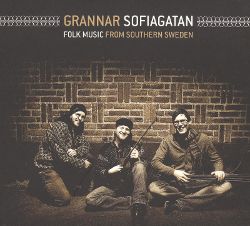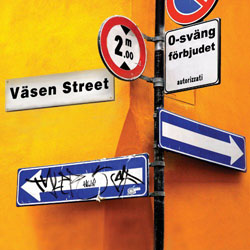“Traditional” is one of those words that gets bandied about a lot these days, particularly when talking about families and music. I’ll leave families to a more political outlet and talk about music here. Now, “traditional” in music can mean a lot of things — ethnographic recordings of Appalachian grannies singing songs they learned as children, work songs and spirituals turned into political anthems, real traditional songs cleaned and neatly pressed for a contemporary audience, sometimes to the point where they don’t have a lot to do with their origins, and songs that may have been traditional once upon a time, or at least in a “traditional” vein, but that not only acknowledge influences from around the world, but happily assimilate them. As far as I’m concerned, these are all legitimate forms of “traditional” music, although I suspect the Appalachian grannies are going appeal mostly to anthropologists.
The reason for this little dissertation is that once again I find myself faced with a group of recordings of “traditional” music from Scandinavia and Minneapolis (which, after all, are not so far apart). So, with all that in mind, shall we?
 Grannar is a trio of Swedish musicians who came together in what may or may not be an unusual way: two of them were neighbors at Sofiagatan who got tired of hearing each other stomping on the floor while playing, so they started playing together. Pär Moberg (soprano sax, harmonica, hurdy gurdy and vocals) was from Skåne, and Jon Sirén (violin, viola, melodeon and vocals) was from Västergötland, both in southern Sweden, so that’s what they started playing, the traditional music from their homes. When they decided to expand their scope a little, they got hold of another neighbor, Martin Eriksson (double bass and vocals), whose origins are unspecified but who also spent a lot of time playing traditional music — in fact, playing any kind of music. They didn’t stick to strictly traditional tunes for long, however, but soon started adding their own compositions, still in a traditional mode, but opening up the possibilities a little. Sofiagatan is their first release. (And, in case you were wondering, “grannar” means “neighbors.”)
Grannar is a trio of Swedish musicians who came together in what may or may not be an unusual way: two of them were neighbors at Sofiagatan who got tired of hearing each other stomping on the floor while playing, so they started playing together. Pär Moberg (soprano sax, harmonica, hurdy gurdy and vocals) was from Skåne, and Jon Sirén (violin, viola, melodeon and vocals) was from Västergötland, both in southern Sweden, so that’s what they started playing, the traditional music from their homes. When they decided to expand their scope a little, they got hold of another neighbor, Martin Eriksson (double bass and vocals), whose origins are unspecified but who also spent a lot of time playing traditional music — in fact, playing any kind of music. They didn’t stick to strictly traditional tunes for long, however, but soon started adding their own compositions, still in a traditional mode, but opening up the possibilities a little. Sofiagatan is their first release. (And, in case you were wondering, “grannar” means “neighbors.”)
Listening to this collection, the traditional influence is obvious, but there are intriguing variations. “Lik 10 Andra,” for example, is a very straightforward folk song, with the added attraction of some virtuoso work on the double base by Eriksson. “En Svunnen Tid,” which follows immediately, begins with a solo by Eriksson — yes, on the double bass — and resolves itself into a very nice traditional ballad. If our ears had not already been alerted by “Grannar’s Waltz,” we would really think we were in for fifteen tracks of Swedish folk tunes. The waltz is a step outside that arena, I think — smoothly sensuous, sounding as much Irish as Swedish, it defies any attempt to assign a locale. So, what we have is music that is, yes, traditional, and traditional in a largely Scandinavian way (if you can separate Nordic traditions in music from Celtic traditions, which I find harder and harder to do the more I am exposed to both), but also music that has absolutely no compunctions about breaking that mold when necessary.
What’s more fun to talk about is the marvelous sounds these three pull out of their instruments. “Juliregn” is simply unclassifiable, the combination of violin and soprano saxophone creating colors that in my experience are pretty much unique, punctuated very nicely by a light touch on the bass, all in the service of a lilting tune that, if we were some distance west, would immediately be dubbed a reel. And then we catapult immediately into the very Highlands-sounding opening of “Avskedvals/Langans Tankar.” Brace yourself — the whole disc is like that, with tunes that might have started off as traditional but went their own way, given a startlingly fresh sound by three talented musicians.
 Väsen recently celebrated their twentieth year as an entity, marked by the release of Väsen Street. The name of the band comes from a Swedish word with a number of meanings, among them “spirit” and “noise” — what better name for a group of musicians? They are a legendary band in what these days is termed “folk rock” circles, and it’s easy to see why. Väsen Street is marked by fluent, masterful musicianship and a repertoire that owes a great deal to tradition but equally much to the here and now.
Väsen recently celebrated their twentieth year as an entity, marked by the release of Väsen Street. The name of the band comes from a Swedish word with a number of meanings, among them “spirit” and “noise” — what better name for a group of musicians? They are a legendary band in what these days is termed “folk rock” circles, and it’s easy to see why. Väsen Street is marked by fluent, masterful musicianship and a repertoire that owes a great deal to tradition but equally much to the here and now.
A case in point is “Asko Pasko Polska,” lively enough, but not exactly what I’ve come to expect from a polska. There’s a thread of melancholy here, perhaps a carryover from “Last Waltz,” the preceding selection, a beautiful, understated tune that calls forth moonlit nights and farewells. “Asko Pasko Polska” lends passion to that sadness. The title track is again a lively tune with a weight to it that one doesn’t as a rule encounter in traditional music’s lighter moments. (It’s also a nod to fans in Bloomington, Indiana, who are trying to get a street named after the band, hence the album’s title.)
That these three musicians stretch the limits of “traditional” goes without saying. If you want a good case in point — at least, one of the most obvious — listen to the opening of “Yoko,” the final track: a soft guitar solo by Roger Tallroth that shares space with sounds from either Olov Johannson’s nyckelharpa or Mikael Marin’s 5-string viola (don’t ask me to figure it out) that in their quality and intervals echo the late twentieth-century avant-garde, at least to my ears, although the tune ultimately resolves itself into one of those songs that could be from almost anywhere.
It may serve to summarize my reaction to this collection to note that the “portrait” pictures of the three musicians show their hands as they are playing. It’s a perfect rendering: the sureness, the energy, the excitement are all there.
O
Kari Tauring is a storyteller, musician, and staff carrier (Völva) based in Minneapolis. The songs included in Völva Songs were all taken from traditional Nordic sources and offer a slightly different take on “traditional” music. This EP is composed of a selection of runesongs and passages from the sagas set to music by Tauring and given pared down performances, sometimes almost stark, but nevertheless conveying the richness of their origins. The passage from the Voluspa, for example, “Voluspa Kariola, although seemingly simple in execution, becomes a strongly textured rendering of the text, almost hypnotic, through no other means than voice, guitars, and occasional sotto voce choral interjections. Tauring’s performance of “Drømte Mig” reminded me a little of Buffy Sainte-Marie’s rendering of the Scottish song “Fire, Fleet and Candlelight” — although lacking the vocal pyrotechnics of which Sainte-Marie has been a master, there is an eerie quality to the delivery here that offers a bit of a chill down the spine. Tauring follows that selection with “Lita Bla,” a gentle song, almost a ballad.
Tauring’s voice is a supple, evocative instrument with an admirable range of expression, and the spare settings of these selections, sung in Votic, Norwegian, Icelandic, and English, with Tauring’s vocals supported by Drew Miller and Scott Nieman, throw them into sharp relief. And let me point out that, while the texts are certainly traditional, the music is twentieth century.
I suspect I’m never going to resolve the question of just what constitutes “traditional” music, and after listening to these three albums, I think I’m probably not going to worry about it overmuch. It’s too much fun just to kick back and listen.
(Evolving Traditions, 2008)
(Northside, 2009)
(Kari Tauring, 2008)
